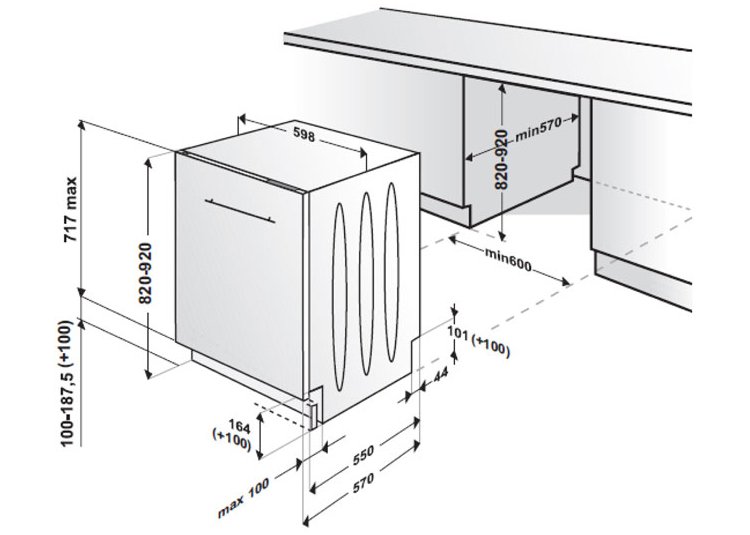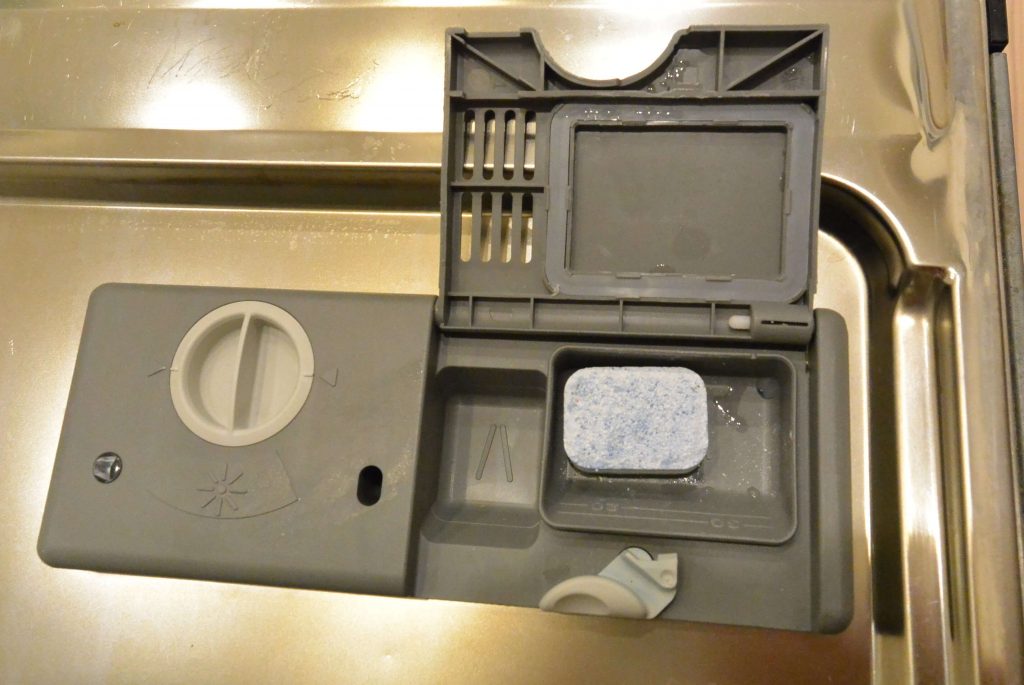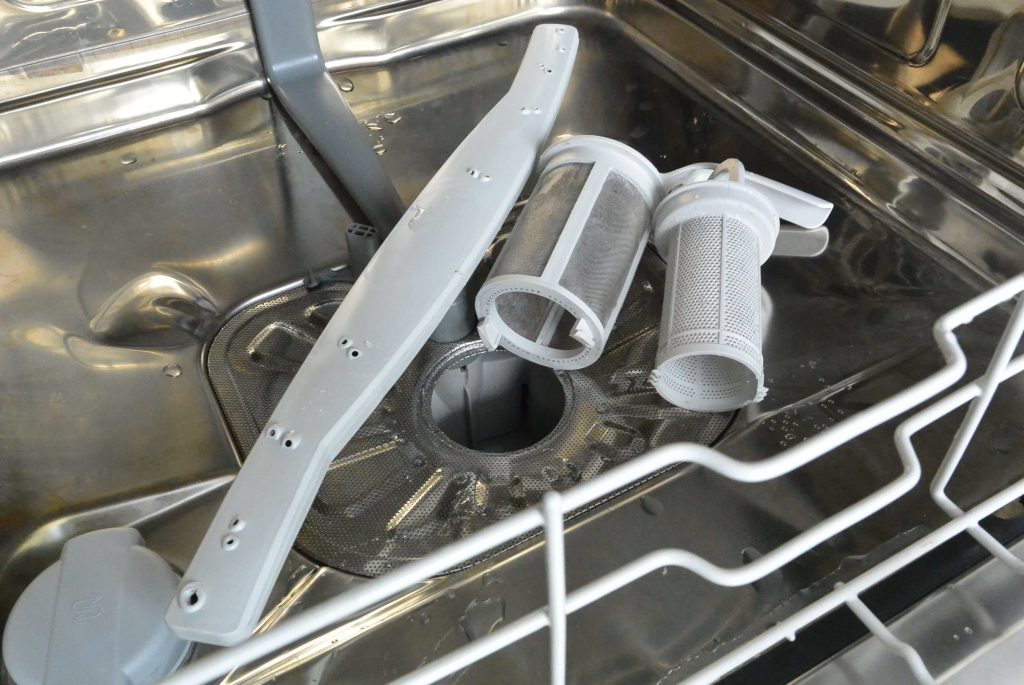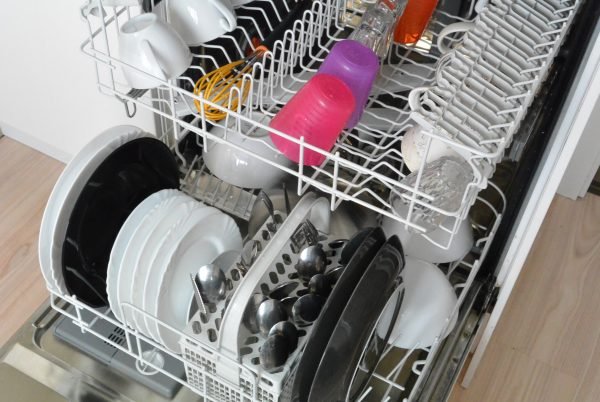The dishwasher is a simple and easy to use kitchen appliance that does not require special handling skills. It is better to leave installation and connection to a professional, but with instructions and tools you can manage on your own. At first, it takes 15-20 minutes to install and start the dishwasher.
Sizes of dishwashers
Most models of standalone and built-in dishwashers have a standard width of 60 cm or 45 cm.
Narrow dishwasher is quite suitable for one user or small family of 2-3 people. It can hold up to 9 sets of dishes and fits well in small kitchens.
A full-size dishwasher, which is 60 cm wide, is the best choice for a family of three or more people. It washes 12-14 sets at the same time.
There are dishwashers of non-standard sizes. Large units are designed for catering establishments and are rarely installed in home kitchens.
Compact dishwashers in size hardly exceed the microwave oven and can be installed even on the countertop. The capacity of such a small dishwasher is 6 sets, which is enough for one person.
How much water does the dishwasher consume?
The amount of water consumed depends on the size of the dishwasher. Not only the overall size, but also the capacity indicator. The more sets of dishes that can be washed at a time, the higher the value of water consumption.
A compact model for 9 sets will consume about 10 liters of cold water per cycle, a full-size model for 12 sets – about 13 liters. In any case, the water consumption for washing by hand exceeds these figures by almost four times, besides, it is necessary to use hot water.
Water costs vary in different operating modes. In the instruction manual or technical specification, the number of liters required for each mode is indicated for the device. If the documents are lost, then you can find the information on their website or ask the manufacturer.
Economy modes
To protect the environment and save resources, each dishwasher is equipped with an “Eco” mode, requiring lower water and electricity costs. One cycle will take 3-4 liters less than the standard washing program.
The half-load mode provided in a number of models, when one of the sprayers is not involved saves water as well.
How much energy does the dishwasher consume?
The amount of electricity consumed is reflected in the energy efficiency index. The energy consumption class assigned to a particular model is always indicated in the instruction or technical product card.
When determining the class, the energy consumption in the “Eco” mode is taken into account when the boxes are fully loaded. A good dishwasher has classes B, A, A +, A ++, A +++. Dishwashers of class C and lower are outdated models, produced more than 10 years ago.
The recommended “Eco” mode saves resources, but heats the water only to 50 ° C. For very dirty dishes this temperature may not be enough. If the result of washing is satisfying, try to choose a different mode.
The class A dishwasher consumes no more than 1.07 kW and not less than 0.7 kW in the Eco washing mode. When choosing a standard program, the power consumption will increase by approximately 0.3 kW.
The delayed start program allows owners to save on dishwashing at night (at a low rate).
What to use for dishwashing in a dishwasher
Products for dishwashing are sold in the departments of household chemicals of any supermarket, hardware stores and household appliances stores. They are sold in different forms:
- Tablets
- Powder
- Liquid
Tablets 3-in-1 contain salt, substances for washing and rinsing dishes, so that you do not have to add anything else. It is convenient to use tablets – just open one and place into a detergent container.
Economical housewives will like liquid or powder more. They can be dosed according to the situation, depending on the degree of dirt and the number of dishes.
The products that are gaining popularity with the notation “ECO” are also issued in different forms. They are free of phosphates and preservatives, and active substances undergo dermatological safety control.
Soap and dishwashing detergents are not used manually in dishwashers, as they cause excessive foaming.
Salt and rinse aid
Regenerating salt is poured into a special compartment of the lower part of the machine. It softens hard tap water, preventing the formation of scale. Scale damages not only the internal parts of the machine, but also leaves an unpleasant whitish coating on the dishes and internal elements of the dishwasher.
The water hardness index can be determined in several ways:
- Check with local water company,
- Determine by yourself using a test strip. A number of manufacturers provide a strip when buying a dishwasher.
It is not suitable to use regular salt for dishwasher, because it has too fine grinding and is slightly different in chemical composition.
The rinse aid is added to a separate container, from which it is dosed during the rinsing of the dishes. It creates the finest layer on the dishes, the water flows better and leaves no streaks and stains. If the owner is satisfied with cleanliness of dishes without using a rinse aid, then it can be completely left out when washing the dishes.
What to use for cleaning the dishwasher
Regular cleaning of the dishwasher extends the life of the dishwasher. To remove accumulated dirt and eliminate unpleasant odors, you must:
- Inspect the inner camera carefully and remove any debris that has entered it.
- Remove and rinse the strainer thoroughly with a dishwashing detergent or grease remover.
- Check the cleanliness of the rotating water spray nozzles. Very dirty sprayers are removed and rinsed in running water.
- Clean rubber seals with a dry cloth.
- Wash baskets, plastic shelves and trays. If necessary, they can be removed.
For descaling, use special tablets or powder. They are placed in the detergent compartment, then you start the empty machine in the maximum temperature mode.
It is allowed to use baking soda or table vinegar for cleaning.
How to fold the dishes correctly
To clean the dishes well, you need to follow several rules for placing them:
- Always clean the dishes of food residues with a brush or sponge,
- Place the dishes upside down, preferably at a small angle,
- Place heavily dirty dishes below,
- Fragile dishes and glass are placed in the upper basket,
- Do not place dishes close, leave a small gap,
- Do not overload the dishwasher.
Carefully study the badges and inscriptions on the new dishes before you place it into the dishwasher. Silver, wood, painted porcelain and thin glass can be badly affected by high temperatures or unsuitable detergents.
When the dishes are spread out in the baskets, it should be checked whether the individual objects do not interfere with the free rotation of the spray blades.



